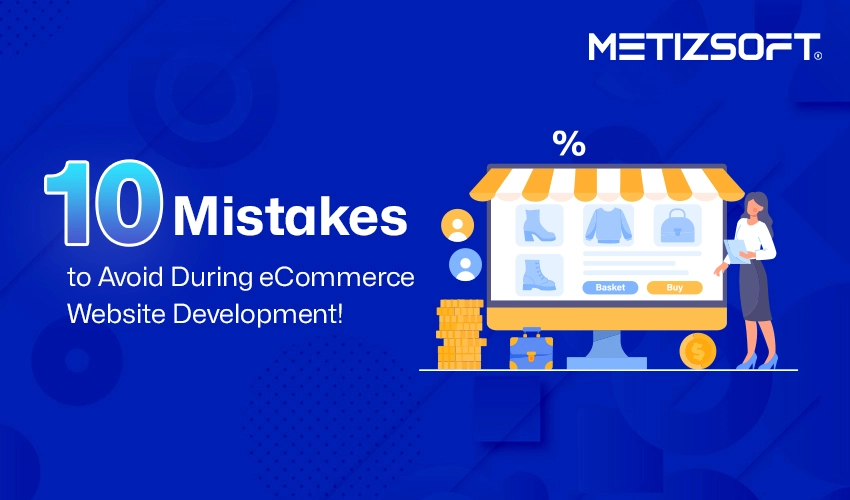
In today’s tech-driven world, bringing businesses online has become a new norm. And why not? It’s the most streamlined way to enrich a global audience and increase sales and revenue. The tech revolution has led many retailers to hire eCommerce developers and move their offline business online in the last couple of years.
The hype and craze to do business online have led to the total number of eCommerce websites worldwide exceeding 26.5 Million, with new sites continuing to emerge every minute. This is no surprise, yet astounding in many ways.
Everyone must make the most of their freedom and access to digital platforms. However, a genuine concern is that many retailers often ignore minor website glitches in due process. These minor issues grow, forcing them to shut down their online store.
In this blog post, we have discovered top eCommerce website development risks that every retailer should pay attention to right from the beginning and avoid at any cost to stay in the digital landscape, ensuring higher revenue most of the time.
Table of Contents
Top Risks to Avoid During eCommerce Website Development!
1. Weak Authentication Process
Weak authentication models can make your site vulnerable to cyber threats like hacking, phishing, and malware, resulting in significant data and monetary losses. A two-factor or multifactor authentication process is the one-stop solution to avoid this issue. Two-factor authentication affixes an extra layer of security to your eCommerce site.
Implementing strong password policies to protect user accounts is crucial. Investing in reliable security systems is also essential to safeguarding your business and clients from cyber-attacks.
2. Payment Security
Cybersecurity has become a vital concern for almost all business owners with online stores or websites. Cyber threats like phishing, malware attacks, credit card fraud, and UPI hacking have turned out to be a hack of an issue from time to time.
To protect yourself and your customers from fraud and danger, you must seek professional help to enable multi-layered security configuration on your website. You can avoid digital payment risks by implementing PCI Scans, requesting non-storable CVV, and integrating an SSL certificate.
3. Outdated Content
Good content is crucial for success, but only if it’s well-structured and accessible from inappropriate language. Hence, use catchy language and headlines to attract customers and display important information like privacy policies and offers.
Update your site whenever necessary and make regular updates to avoid boring customers. Adjust your policies and offers based on customer needs and market trends.
4. Regulatory Compliance
Ensuring regulatory compliance is crucial for your brand’s reputation and effectiveness globally. The Payment Card and Data Security Standards provide tools to secure user transactions.
To enhance security measures, implement strong encryption capabilities, offer role-based controls, and invest in reasonable security solutions. Regularly review all security systems to ensure the complete data safety of your customers.
5. Broken Links
Broken links can significantly impact your eCommerce credibility. Every time a buyer clicks on a broken link, they receive a 404 error, which restricts them from purchasing. Moreover, if your customers encounter broken links during their first visit to your website, they may not return, leading to a potential loss of business.
Therefore, it is crucial to continuously inspect all your website’s links and visit each link repeatedly to ensure they provide relevant results. If you encounter any broken links or offers that need to be fixed, removing them as soon as possible is best to avoid disappointing your users.
6. Call to Action
CTAs are crucial for digital marketing. Invest in simple, catchy CTAs and place them strategically to increase traffic to your site. Even basic buttons like “Let’s Talk” or “Download Now” can drive traffic when positioned correctly.
Consider CTAs’ presence and positioning to avoid hampering your growth and traffic. Follow these tips, and you’re ready to go!
7. Client Disputes & Returns
Wrong deliveries can lead to client dissatisfaction, disputes, and refund fraud. Ensure proper authorization techniques are implemented on your site to avoid these issues.
Use an appropriate payment gateway and avoid charging customers until their item is delivered—additionally, frame clear and concise refund policies for all your items.
8. Improper Search Functionality
Proper search functionality is crucial for website success. Users become frustrated and leave the site if they are still looking for what they need within the first five seconds.
Hence, you must prioritize advanced and Intelligent AI search functionality with voice-based search and personal AI assistants to avoid this.
Image search and voice commands can help users find products quickly, while personalized suggestions enhance the user experience.
9. E-Commerce Intellectual Property
Protecting your intellectual property (IP) is crucial when developing an eCommerce website. IP includes your logos, taglines, content, and other copyright-related material. Violations of your IP can result in significant financial losses.
To safeguard your website’s intellectual property, you should regularly monitor it for unusual activity by implementing AI or machine learning systems. Furthermore, conducting an Intellectual Property audit and obtaining patents for your copyrighted materials, including products, images, and icons, is essential.
10. Warehouse & Logistic Management
Retailers must remember to properly manage their stock and inventories, which can cause significant losses and create stock-out conditions. Poor warehouse management also leads to late deliveries, wrong items being delivered, and running out of stock.
To mitigate this issue immediately, use advanced inventory management software and barcode scanning. In contrast, the best you can do is hire a professional shipping service provider to deal with it, following best practices.
Bottom Line
Mistakes are part and parcel of any work cycle. In the digital landscape, the error margin is thinner than expected. The mistakes listed above are common during eCommerce web development. Knowingly or unknowingly, the chances of these issues occurring are natural.
However, you can avoid these risks for good with sheer attention to detail from the initial stage of your website development. A keen, eagle-eye-like attentiveness can help you save time, effort, and money for extended periods.
Partner with Metizsoft Solutions a renowned eCommerce development company for an in-depth analysis of your eCommerce website. Identify present risks and take initial steps to mitigate them.
AboutManthan Bhavsar
Related Posts
The Importance Of APIs In The E-commerce Business – What Is It, And How Can You Benefit From It?
The past two decades belong to the era of technology and the internet. We have experienced a magnificent digital...
Shopify Partners India Attending Global eCommerce Expo-Mumbai 2018
Metizsoft Solutions attending the Great India e-commerce Expo-Mumbai 2018 as a Reputed Shopify Partner in India. Global...

